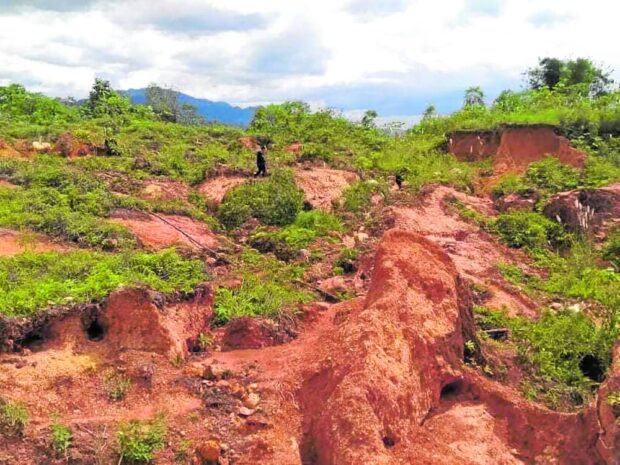
DAMAGED A hill in Barangay Tumpagon, Cagayan de Oro City is heavily damaged by illegal mining operations along the Iponan River as shown in this undated photo. CAGAYAN DE ORO CITY LOCAL ENVIRONMENT AND NATURAL RESOURCES OFFICE PHOTO
CAGAYAN DE ORO CITY— Mayor Rolando Uy on Friday called for collaborative efforts to rehabilitate the Iponan River, a common resource of the city and adjoining localities, from the massive damage wrought by illegal mining activities.
“The damage caused by illegal mining in Iponan River affects both Cagayan de Oro and Opol town in Misamis Oriental as this is a shared river ecosystem. Let us work together to restore it,” Uy said in a statement.
The illegal mining operations along the river again came to light following a raid last May 13 on a mine site in Opol’s villages of Nangcaon and Cauyunan. The operation used heavy equipment and involved five Chinese employing at least 11 locals.
According to the Department of Environment and Natural Resources (DENR), the illegal operation destroyed more than 7 hectares of forest cover.
Improved coordination“I hope that the recently conducted joint operation and the succeeding monitoring and rehabilitation efforts will bring about positive changes and bring to life again the Iponan River,” Environment Secretary Antonia Loyzaga said in a statement on Thursday.
Uy said he would want improved coordination between the local governments of the city, Opol town and Misamis Oriental province in rehabilitating mined areas in the critical Iponan River watershed.
Apart from maintaining law enforcement drive against illegal miners, Uy said it is also essential to strengthen development efforts in communities along the river.
The City Local Environment and Natural Resources Office (Clenro) has been monitoring activities in the river through its Bantay Suba (River Watch) operations, using drone-based mapping technology to aid ground verification.
In its recent report to Task Force Kinaiyahan, a body composed mainly of the Philippine National Police, the Philippine Army, the DENR and the local government, Clenro found traces of extractive activities on the city’s side of the river.
The 60-kilometer long river snakes from the hinterlands of Iligan City in Lanao del Norte down to Opol and on to Cagayan de Oro before draining toward Macajalar Bay.
The mountains along the river, especially in the hinterlands, have been the subject of massive illegal gold extraction activities in the last two decades, employing the hydraulic mining method that uses high-pressure water trained on the hills to dislodge materials believed to contain mineral deposits. The sediments are then channeled to a sluice box that pans the gold.
Massive siltation
Illegal mining operations had been observed in the villages of Taglimao, Pigsag-an, Tuburan and Tumpagon of Cagayan de Oro.Citing DENR data on the river’s water quality monitoring, local environmentalist BenCyrus Ellorin told the Inquirer that mining in the area peaked in 2010 when its total suspended solids were at 992 mg/liter as against the 50 mg/liter tolerable level.
That indicated massive siltation which, in turn, means increased sluicing activities upstream, Ellorin explained.
The river’s “dying state” prompted environmental groups to seek the issuance by the Court of Appeals of a Writ of Kalikasan, which was granted in February 2013. The court directed environmental and law enforcement agencies to act to stop the illegal mining operations in the area.